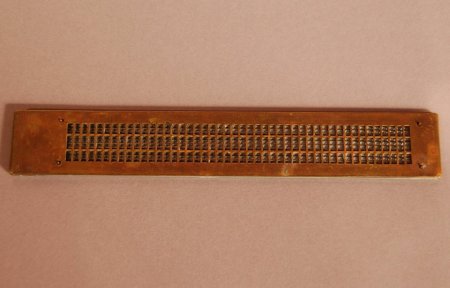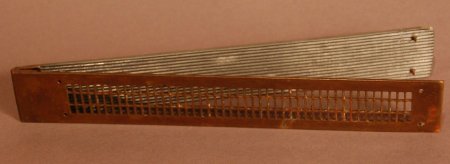Object ID:
2001.211.12
Title:
Ballu slate
Description:
Hinged pocket slate for Ballu writing; top plate is brass; 1 line, 46 columns, 10 dots high; four brass registration pins up in bottom plate; bottom plate is zinc, grooved with horizontal furrows; brass piano hinge is welded to both plates.
Date:
ca. 1885
Made by:
unknown
Place of Origin:
Spain
Provenance:
The Ballu system of embossing tactile print, by embossing dots in the shapes of letters of the Roman alphabet, was invented by Victor Ballu (1829-1907) in 1865. Ballu was a student of Louis Braille and later a professor (of piano) at the National Institute for Blind Youth in Paris, France. He was blind himself, and is also credited with developing interpoint braille printing in France. His Ballu slates, designed to write his system, were also manufactured and used across Europe.
Item is part of a slate collection that belonged to David Ronecker (1918-2001). He was blind since birth, attended the Missouri School for the Blind, worked in Texas as a medical technician for the armed forces, and was an avid collector of slates. He was the uncle of Charles Zinser, who acquired the slate collection after Ronecker's death.
Item is part of a slate collection that belonged to David Ronecker (1918-2001). He was blind since birth, attended the Missouri School for the Blind, worked in Texas as a medical technician for the armed forces, and was an avid collector of slates. He was the uncle of Charles Zinser, who acquired the slate collection after Ronecker's death.
Credit Line:
Museum Purchase, 2001.211

